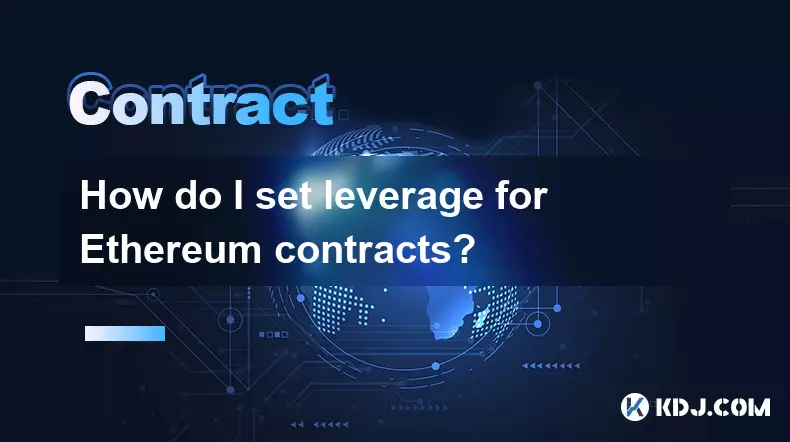-
 bitcoin
bitcoin $112195.049338 USD
2.42% -
 ethereum
ethereum $4124.915858 USD
2.81% -
 tether
tether $1.000570 USD
0.02% -
 xrp
xrp $2.861568 USD
2.25% -
 bnb
bnb $1000.346670 USD
3.04% -
 solana
solana $209.070819 USD
3.38% -
 usd-coin
usd-coin $0.999870 USD
0.02% -
 dogecoin
dogecoin $0.235379 USD
2.65% -
 tron
tron $0.335681 USD
-0.20% -
 cardano
cardano $0.803501 USD
3.38% -
 hyperliquid
hyperliquid $47.120881 USD
3.56% -
 chainlink
chainlink $21.501300 USD
3.44% -
 ethena-usde
ethena-usde $1.000571 USD
0.02% -
 avalanche
avalanche $29.793378 USD
3.62% -
 stellar
stellar $0.366964 USD
2.42%
How do I set leverage for Ethereum contracts?
Leverage in Ethereum futures amplifies both gains and risks, allowing larger positions with less capital—but increasing liquidation risk if the market moves against you.
Sep 26, 2025 at 10:00 am

Understanding Leverage in Ethereum Futures Trading
1. Leverage allows traders to control a larger position using a relatively small amount of capital, known as margin. In Ethereum futures contracts, leverage amplifies both potential gains and losses. Most cryptocurrency exchanges offering derivatives support leveraged trading on ETH pairs such as ETH/USDT or ETH/USD.
2. The mechanism works by borrowing funds from the exchange to increase exposure. For example, with 10x leverage, a trader can open a $10,000 position by depositing only $1,000 as margin. This magnifies returns if the market moves favorably but increases risk of liquidation if the price moves against the position.
3. Different platforms offer varying maximum leverage levels. Some exchanges provide up to 100x for Ethereum perpetual contracts, while others cap it at 25x or lower depending on regulatory compliance and risk management policies.
4. Traders must understand that higher leverage increases sensitivity to price volatility. A minor adverse movement in ETH’s price can trigger a margin call or complete liquidation when using high leverage settings.
5. Setting leverage is typically done before entering a trade and may be adjusted after opening a position on certain platforms, though this depends on the exchange's interface and contract type.
Steps to Set Leverage on Major Crypto Exchanges
1. Log into your chosen derivatives exchange such as Binance, Bybit, OKX, or Bitget. Navigate to the Ethereum perpetual or futures contract section. Select the specific trading pair like ETH/USDT.
2. Before placing an order, locate the leverage adjustment tool—usually found near the order entry panel. It often appears as a dropdown menu or slider labeled “Leverage” showing options like 1x to 100x.
3. Click or tap the current leverage value and select your desired level. Confirm the change if prompted. The system will recalculate your required initial margin based on the new leverage ratio.
4. Choose your order type—market, limit, stop-limit—and input the size of the position. The platform displays the estimated margin needed and liquidation price based on the selected leverage.
5. Review all details carefully. Once satisfied, submit the order. Your position now reflects the chosen leverage, and your profit and loss calculations will scale accordingly with ETH price fluctuations.
Risk Management When Using High Leverage
1. Always set stop-loss orders to limit downside exposure when trading with elevated leverage. Even small market swings can erase margins quickly under high gearing.
2. Monitor funding rates closely in perpetual contracts. High leverage positions held over long periods accumulate costs from recurring funding payments, which can erode profits.
3. Be aware of the liquidation price displayed by the exchange; keep sufficient buffer between current price and liquidation point. Sudden volatility spikes can push prices past this threshold rapidly.
4. Avoid maxing out available leverage simply because it’s offered. Conservative leverage like 5x–10x often provides better risk-adjusted returns than aggressive 50x+ settings.
5. Use isolated margin mode instead of cross-margin when experimenting with high leverage. Isolated margin limits losses to the allocated fund portion, protecting the rest of the account balance.
Common Questions About Ethereum Contract Leverage
How does leverage affect my liquidation price?Higher leverage lowers the distance between your entry price and liquidation price. With increased borrowing, less adverse price movement is required to deplete your margin, making liquidation more likely during volatility.
Can I change leverage after opening a position?Yes, many platforms allow leverage adjustments on existing positions, provided the change doesn’t immediately trigger liquidation. This feature helps refine risk parameters dynamically.
Does leverage impact fees on Ethereum contracts?Leverage itself doesn’t directly alter trading fees, but larger positions resulting from high leverage incur proportionally higher fee amounts since fees are calculated as a percentage of trade value.
Is leverage trading available for spot Ethereum purchases?No, leverage applies only to derivative products such as futures and perpetual swaps. Spot trading involves direct ownership without borrowed funds or margin requirements.
Disclaimer:info@kdj.com
The information provided is not trading advice. kdj.com does not assume any responsibility for any investments made based on the information provided in this article. Cryptocurrencies are highly volatile and it is highly recommended that you invest with caution after thorough research!
If you believe that the content used on this website infringes your copyright, please contact us immediately (info@kdj.com) and we will delete it promptly.
- Navigating Misinformation: Ensuring Safety in the Pi Network Ecosystem
- 2025-09-29 14:25:13
- XRP Price Prediction: September 29th's Crypto Comeback?
- 2025-09-29 14:25:13
- Polkadot vs. Lyno AI: Decoding the Price Forecast and AI Revolution
- 2025-09-29 14:30:01
- Trump's Brahmastra: Can Stable Coin Save the US Economy?
- 2025-09-29 14:45:17
- Pi Movement: Utility, Community, and the $314,159 Dream
- 2025-09-29 14:45:17
- Ruvi AI: Revolutionizing the Creator Economy with AI-Powered Crypto
- 2025-09-29 14:30:01
Related knowledge

How do I use the scheduled order feature in Cardano (ADA) contracts?
Sep 28,2025 at 10:18pm
Understanding Scheduled Orders in Cardano Smart ContractsCardano operates on a proof-of-stakes consensus mechanism and uses the Plutus scripting langu...

How do I enable the "scalping-only" mode for Cardano (ADA) contracts?
Sep 24,2025 at 03:19am
Understanding Scalping Strategies in Crypto Derivatives1. Scalping in cryptocurrency trading refers to executing multiple short-term trades within min...

What is the settlement time for Cardano (ADA) contracts?
Sep 28,2025 at 04:18am
Understanding Cardano's Contract Settlement Mechanism1. Cardano operates on a proof-of-stake consensus model known as Ouroboros, which fundamentally i...

How do I add margin to Cardano (ADA) contracts?
Sep 27,2025 at 07:54pm
Understanding Margin in Cardano (ADA) Smart ContractsCardano operates on a proof-of-stake blockchain that supports smart contracts through its Plutus ...

What is the maximum position limit for Cardano (ADA) contracts?
Sep 23,2025 at 11:00pm
Understanding ADA Futures and Derivatives Market Structure1. Cardano (ADA) futures contracts are offered by several major cryptocurrency derivatives e...

What is the maker fee for Cardano (ADA) contracts?
Sep 26,2025 at 09:01am
Understanding Maker Fees in Cardano (ADA) Contracts1. The concept of maker fees applies broadly across decentralized exchanges and smart contract plat...

How do I use the scheduled order feature in Cardano (ADA) contracts?
Sep 28,2025 at 10:18pm
Understanding Scheduled Orders in Cardano Smart ContractsCardano operates on a proof-of-stakes consensus mechanism and uses the Plutus scripting langu...

How do I enable the "scalping-only" mode for Cardano (ADA) contracts?
Sep 24,2025 at 03:19am
Understanding Scalping Strategies in Crypto Derivatives1. Scalping in cryptocurrency trading refers to executing multiple short-term trades within min...

What is the settlement time for Cardano (ADA) contracts?
Sep 28,2025 at 04:18am
Understanding Cardano's Contract Settlement Mechanism1. Cardano operates on a proof-of-stake consensus model known as Ouroboros, which fundamentally i...

How do I add margin to Cardano (ADA) contracts?
Sep 27,2025 at 07:54pm
Understanding Margin in Cardano (ADA) Smart ContractsCardano operates on a proof-of-stake blockchain that supports smart contracts through its Plutus ...

What is the maximum position limit for Cardano (ADA) contracts?
Sep 23,2025 at 11:00pm
Understanding ADA Futures and Derivatives Market Structure1. Cardano (ADA) futures contracts are offered by several major cryptocurrency derivatives e...

What is the maker fee for Cardano (ADA) contracts?
Sep 26,2025 at 09:01am
Understanding Maker Fees in Cardano (ADA) Contracts1. The concept of maker fees applies broadly across decentralized exchanges and smart contract plat...
See all articles










































































